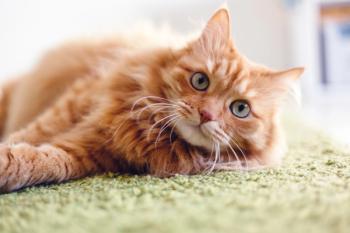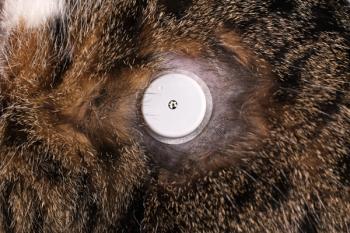
Hyperthyroidism in cats (Proceedings)
Hyperthyroidism is the most common endocrine disorder in cats. This disorder has been noted with increased frequency since the late 1970's. It also appears to be more prevalent in certain geographic locations.
Hyperthyroidism is the most common endocrine disorder in cats. This disorder has been noted with increased frequency since the late 1970's. It also appears to be more prevalent in certain geographic locations.
Normal Thyroid Physiology
The hypothalamus releases thyrotropin-releasing hormone (TRH), which causes the pituitary gland to release thyrotropin-stimulating hormone (TSH). TSH increases production and release of thyroxine (T4) and triiodothyronine (T3), and reverse T3 (rT3) from the thyroid gland. Increased serum T4 is the major factor that inhibits further release of TSH from the pituitary gland. The majority of hormone produced is T4; however it is T3 that is active at the tissue level. T4 is converted to T3 within the tissues. In circulation T3 and T4 are highly bound to proteins, and it is only the free hormone that is available for biological activity. Thyroid hormones affect virtually every tissue in the body. Thyroid hormones increase overall metabolic rate and stimulate protein synthesis and breakdown, carbohydrate metabolism, and fat utilization. Other effects include stimulation of erythropoiesis, formation and reabsorption of bone, increased mitochondrial oxygen consumption, increased heart rate and strength of contraction.
Pathophysiology
The clinical signs associated with hyperthyroidism are a direct result of altered metabolism by excessive amounts of thyroid hormone (T4 and T3) on the target tissues (thyrotoxicosis). Hyperthyroidism in cats is generally a primary disease, meaning that the thyroid tissue is functioning autonomously, and is not secondary to a pituitary or hypothalamus disease.
This disease is generally caused by benign thyroid neoplasia or adenomatous hyperplasia of one (15-20%) or both (70%) thyroid lobes. Thyroid carcinoma is very uncommon (less than 3%). Ectopic thyroid tissue occurs in approximately 3%. There are many theories as to the underlying cause, but none has been proven to be the definitive etiology.
Signalment
Cats range from 4-20 years old, but 95% are >8 years old. Purebred cats are less likely to become hyperthyroid than domestic /mixed breeds. There is no gender difference.
History
The main owner complaints generally include some of the following: polydipsia, polyuria, polyphagia, weight loss, hyperactivity or nervousness, vomiting/diarrhea, tachypnea/panting, weakness, lethargy, decreased grooming, heat avoidance.
Physical Exam Findings
Examination generally reveals one or all of the following: poor body condition, unkempt haircoat, dehydration, tachycardia, arrhythmias/murmurs, abnormal retinal examination (hypertension), and palpable thyroid glands.
Apathetic Hyperthyroidism
This occurs in a subset of cats. It affects approximately 10-14% of hyperthyroid cats. The clinical findings include: decreased appetite, lethargy and occasionally weight gain. In people with this disorder there may be psychological or cardiac abnormalities that contribute to the altered behavior. It has been suggested that many cats with apathetic hyperthyroidism have concurrent renal failure, cardiac disease or neoplasia.
Diagnosis/Diagnostic Testing
There are typical findings on a routine labwork that should give support to pursuing this diagnosis. On a CBC a stress leukogram and erythrocytosis may be seen. On a chemistry panel typical findings would include elevated liver enzymes. Less common findings would include elevated bilirubin, increased BUN, creatinine, and phosphorous. With respect to specific testing, a total serum T4 (TT4) should be the first test performed. This is diagnostic in greater than 90% of patients with the disease. It is possible for this level to be artifactually decreased into the normal range by concurrent disease in a small proportion of cats. Other initial tests that are indicated would include chest radiographs, abdominal ultrasound and systemic blood pressure measurement.
Confirmation of the diagnosis it often made by the serum TT4. If further testing is required, the next step would be to repeat the serum TT4. If this is still equivocal, a free T4 test can be performed. If the diagnosis is still questionable, but the clinical suspicion is there, a T3 suppression test can be performed. Pertechnetate scanning can be performed, depending on the treatment modality anticipated, in order to outline active tissue.
Therapy/Complications
Acute Therapy
Acute therapy is aimed at stabilizing the patient for further work up and therapy. Cardiac complications are the main life threatening complications that may need to be dealt with on an emergency basis. Cardiac complications may require stabilization with antiarrythmic or antihypertensive medications, or thoracocentesis (for pleural effusion) or oxygen therapy.
Chronic Therapy
There are 3 main options for chronic therapy, including medical management, radioiodine therapy, and thyroidectomy. Medical management involves the use of oral or topical antithyroid medications. The most commonly used medication is the thioureylene antithyroid medication, methimazole.
Methimazole blocks thyroid hormone synthesis by inhibition of thyroid peroxidase. This enzyme is involved in the oxidation of iodide to iodine, incorporation of iodine into thyroglobulin, and coupling of tyrosine residues to form T4 and T3. Typical starting doses are 1.25-2.5 mg/cat twice daily. Methimazole can be given either orally or transdermally in a formulation with pluronic lecithin organogel. This allows the drug to absorb across the skin.
Side effects of methimazole can include blood dyscrasias (3-9% of cats), facial excoriation (2-3% of cats), hepatotoxicity (2% of cats), gastrointestinal upset (10% of cats), renal decompensation (15-20% of cats), coagulation abnormalities (rarely), and acquired myasthenia gravis (rarely). The transdermal formulation of methimazole has fewer gastrointestinal side effects (4%).
An option for curing the disease is surgical removal of the affected gland(s). The main concerns with this option would include anesthetic complications, recurrence of the disease (rare), and presence of ectopic tissue (rare).
The third option for cure of the disease is radioactive iodine therapy, considered the gold standard for definitive therapy. It generally requires one subcutaneous injection of the medication. The cat remains hospitalized until the radioactivity in low enough for it to be discharged into the owner's care.
Additional Points
Hyperthyroidism and Renal Disease
It has become known in recent years that hyperthyroidism is linked to chronic renal disease in cats, and that treatment of the hyperthyroid condition can exacerbate the renal disease. Predicting which cats that will occur in has been more difficult. Hyperthyroidism increases glomerular filtration rate (GFR), and therefore there is a predictable drop in GFR following treatment for hyperthyroidism. Whether this becomes a pathologic problem or not is difficult to predict. In one recent study 15% of cats developed renal failure 13-18 months after radioiodine therapy. Parameters that have been looked at include BUN, creatinine, BUN/creatinine ratio, GFR, urine specific gravity, urine retinol binding protein, and N-acetyl-beta-D glucosaminidase (NAG) index, and none have proven to be a reliable indicator.
Current recommendations include medical management of hyperthyroidism for a period of time, independent of the desire for cure of the disease. It is generally accepted that a cat should be managed medically for a period of time (30 days is sufficient), and documented to be euthyroid. If the renal values remain stable, permanent therapy can be undertaken at that time. This is the most conservative and safe method to ensure that the renal disease does not become more serious than the thyroid disease itself.
The Search for Etiologies
Many factors have been investigated, but there is little scientific proof for cause and effect. Some possible etiologies include: goitrogens, selenium, growth factors, circulating thyroid stimulators, or genetic mutations. Recent studies have indicated that exposure to food packaged in a can is a major risk factor for development of feline hyperthyroidism.
Hypertension and Hyperthyroidism
Systemic hypertension is common in hyperthyroid cats. One recent study looked at prevalence at diagnosis and found 13% of hyperthyroid cats were hypertensive at diagnosis. Approximately 23% of hyperthyroid cats that were not hypertensive at the time of diagnosis became hypertensive during therapy. Therefore it is important to follow the systemic blood pressure, even if it is initially normal. Severe hypertension is considered uncommon in these cats, and if present may be indicative of other concurrent disease such as renal failure. Therapy to control the hyperthyroidism does not necessarily control the hypertension, and many cats require long term medications to control the hypertension despite becoming euthyroid.
References available on request.
Newsletter
From exam room tips to practice management insights, get trusted veterinary news delivered straight to your inbox—subscribe to dvm360.




